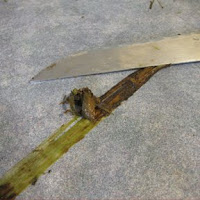
 Hollyhocks are annuals, growing as high as 6 feet. Very easy to grow, and self-seed year after year.
Hollyhocks are annuals, growing as high as 6 feet. Very easy to grow, and self-seed year after year.Unlike paper made from grass and leaf fibers, paper made hollyhock fibers are much stronger, smoother, and less brittle. That is because their fibers are much longer and stronger to begin with.
My sheets were very thin, like tissue paper, but strong. Partly because I don't have have enough fibers, but also because I like to make thinner sheets for my light sculptures. I like the way the delicate fibers show up against the light.
Before boiling the plant in a caustic solution, extra steps are needed to separate the fibers from its woody core and its outer bark. Below are the steps I took from gathering the fibers, to making the paper.
Materials:
- Stainless steel stock pot
- Soda ash
- Stir stick
- Digital Scale
- Papermaking mold and deckle
- Large basin
- Cloths
 Step 1
Step 1 Hollyhocks are gathered from my garden. Remove leaves and roots. Bundle and soak underwater for about a week. During this period, the plant will begin to rot, making the process of removing the fibers much easier. You can add a bit of soda ash solution to speed up the process. I have two kittens running around the house, so I rather wait.
 Step 2
Step 2After about a week, drain and rinse the plant. Begin to strip the fibers. It should just "peel off". But some are more difficult than others. For the difficult ones, I snap the stems to make it easier.
 Step 3
Step 3Scrap off the outer bark. Remove as much bark as possible for a "whiter" paper.
 Left to right: bark, fiber, and woody core.
Left to right: bark, fiber, and woody core.If you wish to continue with papermaking, continue to step 4. Otherwise, dry the fibers and store in a dry/moisture free place. Dry fibers can be store indefinitely. When you're ready to make paper, rehydrate the fibers by soaking it overnight.
 Step 4
Step 4Fill 2/3 of the pot with cold water — you don't want hot water to overflow when you add the grass. Measure out soda ash and add to water. For every 1 liter of water, use 15 grams (1/2 ounce) of soda ash.
When water is beginning to simmer, add fibers. Let it simmer for 2 hours.
Open windows and doors for ventilation. Every 1/2 hour or so, give it a stir.
 Step 5:
Step 5:After 2 hours, the water will be dark and thick. Drain and rinse the fibers until the water runs clear.
 Step 6:
Step 6:Begin to pound the fibers...
 ...until it turns into pulp. I pound for about 45 mins to an hour.
...until it turns into pulp. I pound for about 45 mins to an hour. Step 7:
Step 7:Set up your couching area by layering a pile of cloths.
 Step 8:
Step 8:Fill basin with water and add pulp. Agitate the water to distribute the pulp evenly.
Slide your mold and deckle into the basin, lift up, and let excess water drain.
 Step 9:
Step 9:Remove the deckle and bring the mold over to the couching area. Flip the mold over, paper side down, and sponge off excess water.
 Step 10:
Step 10:Gently lift off mold, and allow the paper to dry flat.
Hello I stumbled across your blog last night and it is full of lots of useful info so I had to follow you.
ReplyDeleteI used to make handmade papers a long time ago from old recycled material but had to stop due to extenuating circumstances but I miss doing so and hope to start again soon. Any plant material I used was pressed into the paper and not used to make the fires so to speak.
Two quick questions, when is the best time to pick the hollyhock for paper making, after before or during flowering stage?
And I never used caustic soda before to make my papers, I gather this speeds up the breaking down process of plant materials, is it absolutely necessary and what would happen if I eliminate this ingredient from the process?
Thanks in advance for replying.
Hello,
ReplyDeleteGlad you stumbled upon my blog!
I'm still learning, experiment with different plants each day.
But for the hollyhocks, I harvest after they've seed, so that I'll have hollyhocks for next year.
Caustic soda will raise the water's PH to about 10, thus helps to break down the plant material, and to kill insects/eggs that might be living in there.
I read in books that if you don't use caustic soda, the paper will rot over time, and insects (if there are any eggs) will hatch!
Since I'm using my papers for my sculptures, I NEED to use caustic soda.
If I left anything out, let me know.
Joanne
Thanks for the reply, I'm glad I get to leave the holly hocks till they self seed. I grow lots of plants in me flower garden for herbal reasons so I think I'll try and experiment with others and will let you know how I get on.
ReplyDeleteSo the caustic soda is to help break down fibres and to kill insect eggs, that makes perfect sense and to preserve your beautiful sculptures is a definate good reason for using.
I'll have to see how easy it is for me to get it over here.